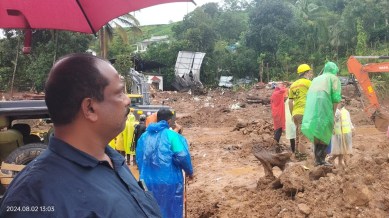Stay updated with the latest - Click here to follow us on Instagram
26 relatives lost, excavator operator in Qatar now waits for one to dig up his brothers in Wayanad
The 51-year-old had rushed home as soon as he heard about the devastating landslides that struck Mundakkai and surrounding areas early on Tuesday

Shoukath worked as an excavator operator for 30 years in the Middle East, and on Friday at his native Mundakkai village in Kerala’s Wayanad, he watched as an excavator dug through the mud in search of his two brothers and 24 other members of his family.
The 51-year-old had rushed home from Qatar as soon as he heard about the devastating landslides that struck Mundakkai and surrounding areas early on Tuesday.
The death toll from the landslides, which covered whole villages in mud and debris, rose to 210 on Friday. Another 218 people are still missing. The government does not expect to rescue anyone else alive, with Chief Minister Pinarayi Vijayan saying Thursday that only bodies were left to be retrieved from the worst-hit villages of Mundakkai, Chooralmala and Attamala.
The dead included members of several families that were completely wiped out – either swept away into the raging river or buried under mud and debris.
“Everything is lost. My brothers, their families… everyone is gone. So far, only four bodies have been recovered. My wife and son escaped only because they rushed to the hill after the first landslide. My two-storey house, which I constructed using my hard-earned money, was reduced to rubble. I have no place to go,” Shoukath said.
After starting his journey as soon as he heard the news of the landslides, Shoukath reached Wayanad on Wednesday. It was only on Friday, however, that he was able to get to Mundakkai village, where his brothers and family members lived near each other in the same area.
The landslides had washed away the major bridge on the river Iruvazhinji, making it very difficult for rescuers to reach Mundakkai. After several hours, some rescuers managed to get across the river using ropes. The next day, the Army and National Disaster Response Force teams managed to install a rope bridge, giving rescuers slightly better access to the village that was at the epicentre of the landslides.
A day after that, Army personnel completed the installation of a Baily bridge, for which parts were flown in from New Delhi. While this gave further momentum to the rescue operation, officials were discouraging locals from crossing it and going to Mundakkai.
On Friday, Shoukath managed to get across the bridge and finally return to his native village. By then, the rescue operation had turned into an effort to recover as many bodies as possible.
Walking towards the area where his family’s houses once stood, he saw earth movers scooping out mud and moving boulders in search of bodies. There he saw his family’s neighbour, Mohanan, who lost five family members himself.
When Shoukat asked him about the fate of others in the neighbourhood, Mohanan simply said: “They’re all gone.” Among those were Mohanan’s mother, elder brother, sister-in-law and their two children.
The search for bodies in the villages, divided into six sectors, were being conducted by 40-member teams – each comprising personnel from the NDRF, Navy, Army, Defence Security Corps, state rescue personnel, and others, officials said.
Officals said a drone-based body detection system will be deployed on Saturday for recovery of bodies.
The Navy and Coast Guard also ramped up the search in Chaliyar river, where several bodies were already found. The Iruvazhinji, which flows through the affected areas, merges with Chaliyar river further downstream.
Of the bodies recovered so far were 74 that could not be identified. On Friday, the state government decided to cremate them at different public crematoriums in nearby panchayats.